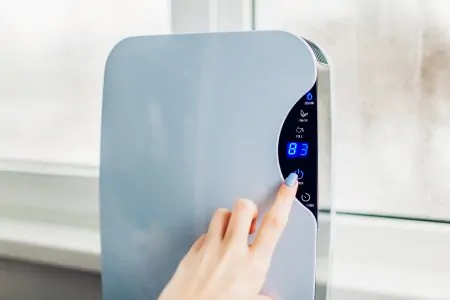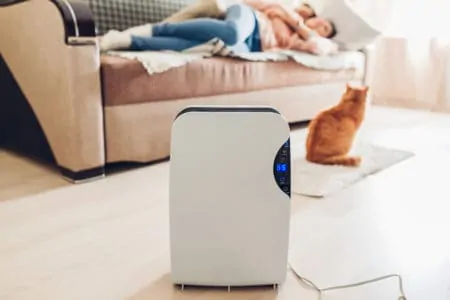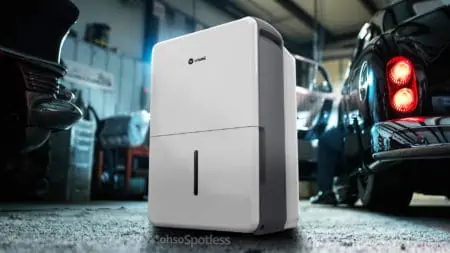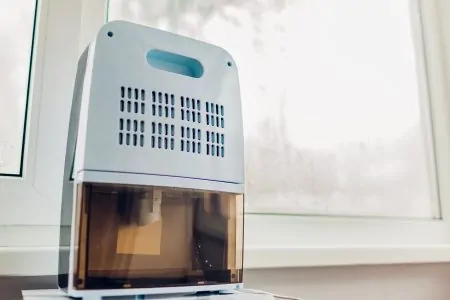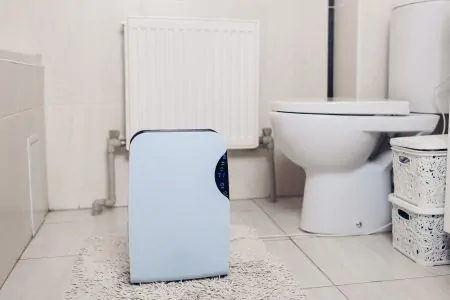When it’s hot and humid, it can be uncomfortable to do anything other than lounging on the couch with an ice-cold drink. We often use countless amounts of energy and electricity to keep ourselves cool when indoors.
To save some energy, you might wonder: do dehumidifiers cool the air? Can you cut back on AC?
It turns out a dehumidifier can actually do the opposite. Let’s learn all about dehumidifiers and their effect on the surrounding area.
Key Takeaways
- Dehumidifiers remove excess moisture from the air and come in three main types: refrigerant, desiccant, and whole house.
- Refrigerant dehumidifiers work similarly to air conditioners by cooling the air to extract moisture, then reheating the air before releasing it.
- Dehumidifiers are not meant to cool a room but can help make it more comfortable by reducing humidity.
- Using a dehumidifier alongside an air conditioner can help create a cool and dry environment while saving energy.
How Do Dehumidifiers Work?
Dehumidifiers remove excess moisture from the air, creating a more comfortable environment.
There are three main types of dehumidifiers: refrigerant, desiccant, and whole house — the most common being the refrigerant.
Refrigerant
Refrigerant dehumidifiers work very similarly to air conditioners by drawing in warm air, cooling it, and thereby extracting moisture.
As the fan draws in moist air, it crosses the cooled coils, causing the moisture to condense. You see, when the air is cooled, it won’t be able to retain moisture and forms condensation. This moisture will then drop from the coils into the bucket (1).
When the moisture is removed, the air is reheated before leaving the dehumidifier. The reheating of the air is essential for it to remain as dry as possible. The new dry and slightly warmer air will attract moisture, which is then drawn into the dehumidifier.
Most refrigerant dehumidifiers also have a defrost system that keeps the coils running smoothly. An essential feature of many dehumidifiers is an auto-shutoff function; this automatically turns the unit off when the bucket is full.
In other words, it helps to prevent the water from overflowing, which could damage the dehumidifier. Moreover, if the bucket isn’t full, most dehumidifiers will continue to run until the desired humidity levels are achieved.
Desiccant
The most common desiccant version is called a full-size consumer-grade desiccant dehumidifier. It works by drawing air into the unit using a fan. A desiccant material will then adsorb moisture (2).
Furthermore, when heated, the desiccant material can release moisture, which is critical for the function of the dehumidifier. A large rotating drum made up of alternate layers of corrugated and flat sheets hold the desiccants. The sheets are arranged to allow air to flow perpendicular to the drum.
This type of dehumidifier also contains a condenser, which is made of plastic. Its role is to condense moist warm air. In addition, the heater is required to reheat the air before it’s released back into the room.
However, this isn’t the only type of desiccant dehumidifier — there are multiple types, including:
- Disposable desiccants: These are also commonly known as moisture adsorbers. They’re easy to use, affordable and effective in small rooms. People often use disposable desiccant dehumidifiers in closets, cars, and small RVs.
- Rechargeable desiccants: This type of dehumidifier is also quite small, similar to disposables. They contain a desiccant you can recharge by plugging the device into an outlet.
- Commercial desiccants: These are commonly rented by contractors and are typically used in construction. Commercial desiccant dehumidifiers have an incredible ability to dry already dry air. They can also work in extreme temperatures where refrigerant dehumidifiers simply won’t be able to.
Whole House
Whole house dehumidifiers are an excellent option for multiple-story houses struggling with humidity. This type of dehumidifier is generally ducted to your already existing HVAC system.
Most importantly, whole house units dehumidify the air before it enters your home. This protects you from mold, dust mites, and other humid-thriving bacteria.
Additionally, whole-house dehumidifiers generally last for longer compared to portable units. They also come with longer warranties. However, they use a significant amount of electricity.
Will They Cool the Room?
Before we answer this question, it’s important to note that dehumidifiers aren’t meant to cool a room. That’s the job of the AC. However, that doesn’t mean they can’t help to make a room more comfortable.
As we concluded above, most dehumidifiers create warm or hot air released back into the room. This is crucial to maintain the efficiency of the dehumidifier, whether refrigerant or desiccant. Because hot air attracts moisture, the dehumidifier can draw more moisture out of a room.
In addition, the compressor of a dehumidifier will also produce some heat that will affect the room. However, there’s a way around this slight issue to create a comfortable living space.
Save Energy
Dehumidifiers vs. Air Conditioners?
Air conditioners and dehumidifiers are functionally the same, but they work to create different results. Both appliances (depending on the type) circulate refrigerant through the system, changing it from gas to liquid and vice versa (3).
Despite being very similar in function, there are two distinct differences between dehumidifiers and air conditioners:
Air Movement
As the AC unit pulls warm air in and cools it over the coils, it pumps out cold air for us to enjoy. The hot air produced by the condenser is then moved outside, creating a cool indoor environment.
In contrast, dehumidifiers don’t care about your overheating body. They dump dry, warm air right into your living room.
Moisture
How air conditioners and dehumidifiers deal with moisture is very different, even though both create condensation on the coils. Air conditioners collect the water in a pan, which is then drained outside. They do this differently depending on the unit, either through a tube or a drip edge.
On the other hand, dehumidifiers are built to hold the water they create. Portable units have a water reservoir that can hold anything between a few ounces to gallons, depending on the size.
Most dehumidifiers also have the option of continuous drainage by attaching a hose to an outlet in the unit. The water will then leave the dehumidifier using gravity to a nearby drain. In addition, some dehumidifiers are equipped with a built-in pump that helps to move water out of the unit.
Keeping It Cool
Dehumidifiers are highly effective at drying the air. However, they need a little help to keep it cool.
As the air is cooled on the coils, it’s reheated before being emitted back into the air. The compressor also creates heat. As a result, dehumidifiers will actually raise the air temperature by up to 15 degrees.
Fortunately, there’s a way around this: utilizing another beloved home appliance, the air conditioner. By using the two appliances at the same time, you can effectively create a cool and dry environment.
